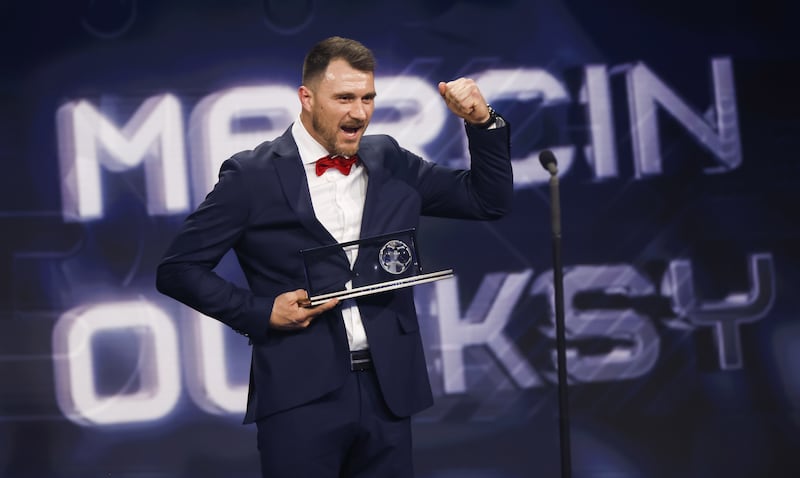The ridiculously overpriced, pompous and borderline unnecessary Fifa Awards, The Best, were on during the week in Paris, where the world’s best and most famous footballers congregated to honour award nominees, best XIs, best female player and best male player.
Time and time again, you’re reminded by the hosts that these are The Best.
I had just started working in women in sports when Stephanie Roche was nominated for her brilliant goal for Peamount United. At the time, women’s football was quite an afterthought at these events, and, ironically enough, the event budget was far superior to what was being pumped into women’s sports.
Admittedly, the exposure that came from Roche’s nomination was never actually capitalised on properly, but it did bring women’s football to the forefront of people’s minds for a short time.
Irish player tracker: Ipswich’s Dara O’Shea stars against Wolves despite defeat
The least romantic fans in football, and the Man City player’s long-serving underwear
Arne Slot is shocked by errors as Liverpool’s Premier League run ends at Fulham
Shamrock Rovers footballer Dylan Watts: ‘My time in England was tough’

The Puskás Award is generally one of the few awards that literally has no boundaries. Score an incredible goal, hope to the heavens someone catches it on video and then throws it up online. Usually, in this day and age, things like that go viral.
So, when the nominee shortlist came out for this year’s Puskás Award, familiar names were featured, Kylian Mbappé, Dimitri Payet, Richarlison, Alessia Russo and so on. Somewhere buried on the original shortlist was Marcin Oleksy. You’d probably be forgiven if you didn’t know him.
Marcin Oleksy is a Polish amputee footballer competing in the local Polish league for Warta Poznan. In their game against Stal Rzeszow, Oleksy scored a goal that made him a Puskás winner.
Let me set the scene for amputee football if you are not familiar. Imagine your average football team lining out on a pitch. Now, imagine those on the pitch, except for the goalkeepers, who are missing part of their upper limbs, and are missing one of their lower extremities.
Imagine all that the players have to keep them balanced are crutches and their only remaining leg. Now, imagine them racing against each other on their crutches, powering up and down the field, dribbling the ball, putting in tackles, and dinking in lovely crosses.
Now, picture Oleksy, a man who lost his leg over 12 years ago in a work-related accident while working on roads when heavy machinery fell on top of him, injuries so bad it was better to amputate.
For his award-winning goal, Oleksy leaps up with the help of his crutches, and let’s be honest, that cross was served on a platter. He contorts his body, effectively a one-legged bicycle kick . . . bang, back of the net.
I’m sure physicists or those who work on the laws of weight distribution will disagree with me, but being able to bicycle kick using a crutch as the only leverage and thing to balance with while kicking a ball with your only leg, has to defy some laws on gravity.
Here’s the thing with disability sports, though. We only see them every four years in conjunction with the Olympic/Paralympic cycle, and they are so very rarely in front of us that it’s hard to actually imagine these athletes playing football.
The Irish Amputee Football Association (IAFA) was set up in April 2011, and there is an international squad representing the Republic of Ireland.
Amputee football is seven-a-side. There are no offside rules, and players can’t use their crutch when advancing the ball, ie can’t use the crutch to hit the ball. It’s essentially deemed as a handball, like in non-amputee football. Each half is 25 minutes long, with half-time lasting 10 minutes. Naturally, using a crutch in the tackle is a sending-off offence.
Shamrock Rovers, Bohemians and Cork City are the leading clubs in Ireland who have an amputee team, and they play a league against amputee footballers from Scotland. The leagues have been running for the last few years, while international tournaments also run to bring the best in the world together.
It should come as no surprise that Brazil are the second most decorated team in the world, with Russia just pipping them out in terms of most medals won.
The next step for amputee football is to be recognised as a Paralympic sport, next to goalball and blind football, as well as sitting volleyball. With its athleticism, raw talent and now, thanks to the Puskás Award, amputee football has captured a global audience and, with that, exposure to build and grow.
In fact, with disability sports having a more significant platform now, hopefully, it will encourage younger athletes or amputees to pick up the sport and give it a go.
The biggest thing within amputee football is a sense of community and belonging. Everyone forgets their worries and the fact that they have a disability. In fact, it’s one of the rare places where disabilities are normal.

















